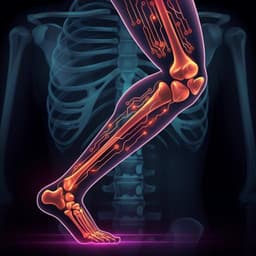Introduction
The design of robots capable of navigating complex and unpredictable terrains is a significant challenge in robotics. Nature offers numerous examples of highly resilient and fault-tolerant locomotion strategies, often employing multi-functional appendages. Birds, such as Chukars and Hoatzins, demonstrate remarkable locomotion plasticity by repurposing their wings for quadrupedal walking and wing-assisted incline running. This ability to adapt their locomotion to diverse environments significantly expands their habitat range. Biomimicry of these strategies offers the potential to create mobile robots with unparalleled capabilities. This research aims to design a robot that leverages this principle of appendage repurposing for enhanced locomotion plasticity. The resulting robot, the Multi-Modal Mobility Morphobot (M4), is designed to negotiate unstructured environments encompassing both land and air. M4's multi-functional components, composed of various actuator types, allow it to perform a wide range of locomotion modes, including flying, rolling, crawling, crouching, balancing, tumbling, scouting, and locomanipulation. This versatility is particularly relevant in scenarios such as search and rescue operations following natural disasters, where the environment may be highly unpredictable and require diverse mobility capabilities. The robot’s ability to transition seamlessly between these modes enables it to adapt to the specific challenges presented by the environment, maximizing its effectiveness.
Literature Review
Existing multi-modal robots can be broadly categorized into two main design views: morpho-functionality and redundancy. Morpho-functional designs achieve multi-modal locomotion through body and appendage morphing, using articulated bodies and appendages that can transform into different forms (e.g., legs, wings, wheels). While many promising designs have been introduced, these robots often demonstrate limited locomotion plasticity (two to three modes) and face scalability challenges, especially with soft-bodied robots. Redundant designs achieve multi-functionality by using a plurality of appendages, each dedicated to a single function. While simpler, these designs quickly face added mass issues, limiting the number of integrable modes and hindering scalability. This study explores a third design view: manipulation of redundancy through morphing. This approach draws inspiration from animals that utilize morpho-functional structures and repurpose appendages to create or eliminate redundancy as needed, maximizing locomotion plasticity and efficiency. While some existing robots utilize appendage repurposing, their locomotion plasticity and scalability are limited compared to the capabilities of M4. M4 represents a significant advancement by exploiting appendage redundancy manipulation through morphing to achieve a high degree of locomotion plasticity and scalability.
Methodology
The M4 robot is designed with an articulated body and four legs, each equipped with two actuated hip joints (frontal and sagittal) and a shrouded propeller that functions as both a wheel and a thruster. This design allows for various transformations between locomotion modes. The robot's dynamic model, derived using the Euler-Lagrangian equation of motion, accounts for the interactions between the robot's various components and the environment. The control system employs an optimization-based approach, specifically the direct collocation method, to handle the dynamic constraints and optimize control actions in real-time for maneuvers like the mobile inverted pendulum (MIP) and wing-assisted incline running (WAIR). Path planning is achieved using a multi-modal probabilistic road map (MM-PRM) algorithm coupled with an A* algorithm to find the optimal path considering the energy consumption of each locomotion mode and the transitions between them. The MM-PRM algorithm generates a graph representing the navigable space, incorporating both ground and aerial nodes and considering constraints for each locomotion mode. The A* algorithm then searches this graph to find the optimal path minimizing the total energy consumed. The energy cost of performing locomotion is estimated from current load and reference voltages of all motors.
Key Findings
Experimental results demonstrate M4's capacity to perform eight distinct locomotion modes: flying, rolling, walking, crouching, balancing, tumbling, scouting, and locomanipulation. The robot successfully navigated a pond using a combination of wheeled and aerial locomotion. The MIP maneuver allowed M4 to self-upright and dynamically balance on two wheels, providing increased reach and enhanced traction. M4 also demonstrated crouching to pass under low clearances, object manipulation in MIP mode, and quadrupedal locomotion on rough terrain. Autonomous multi-modal path planning experiments were conducted using both off-board and on-board sensing and computing. The robot successfully navigated a complex environment, autonomously switching between UAS and UGV modes, to reach a designated goal point. Furthermore, M4 successfully executed WAIR on a 45° slope and performed a tumbling maneuver to overcome obstacles too large for wheeled or legged locomotion. The experiments showcased the scalability of the design, demonstrating successful fully autonomous, self-contained multi-modal operations. The energy cost analysis reveals that UGV is the most energy-efficient mode, while UAS is the most energy-intensive. Intermediate modes, such as tumbling and thruster-assisted MIP, offer energy efficiency advantages over UAS while enabling traversal of challenging terrain.
Discussion
The results confirm that the approach of manipulating appendage redundancy through morphing is highly effective for achieving both significant locomotion plasticity and scalability in a single robotic platform. M4 surpasses existing multi-modal robots in terms of the number of locomotion modes and the level of autonomy achieved. The ability to seamlessly transition between various modes, adapt to diverse terrains, and perform complex maneuvers highlights the potential of this design approach. The successful demonstration of autonomous multi-modal path planning using onboard sensors and computing underscores the potential for practical applications in real-world scenarios.
Conclusion
The development of M4 demonstrates the significant advantages of bio-inspired design principles for creating highly versatile and adaptable robots. Future work will focus on expanding M4's capabilities by incorporating more sophisticated legged locomotion gaits, improving object manipulation dexterity, and developing more robust autonomous decision-making algorithms for mode selection in complex environments. The integration of advanced autonomy and manipulation capabilities will enhance M4's potential for applications in search and rescue, space exploration, and other challenging domains.
Limitations
While M4 exhibits remarkable locomotion plasticity, certain limitations exist. The current design lacks knee joints in the legs, which restricts the range of natural gaits that can be implemented. Object manipulation capabilities are currently limited to simple grasping. The autonomous decision-making algorithm for mode switching requires further development to handle highly complex and dynamic environments. The energy consumption of the robot is relatively high, particularly in UAS mode, which needs to be addressed for extended operational capabilities.
Related Publications
Explore these studies to deepen your understanding of the subject.







